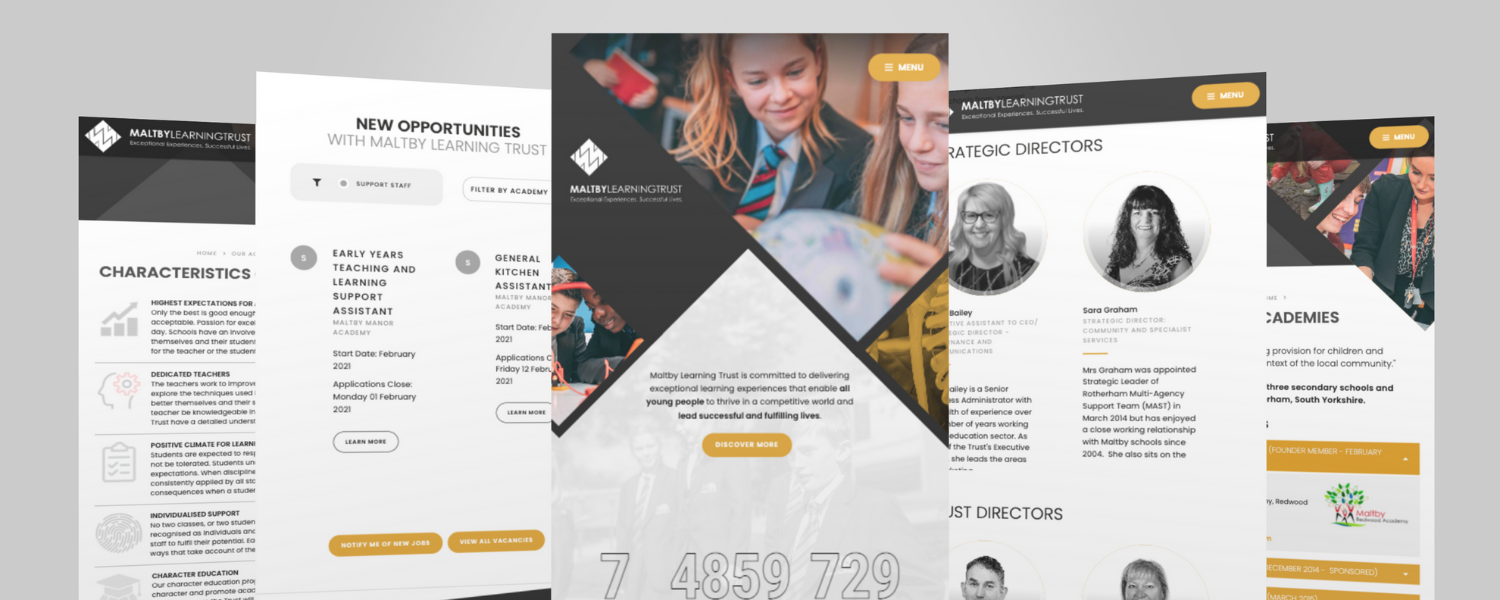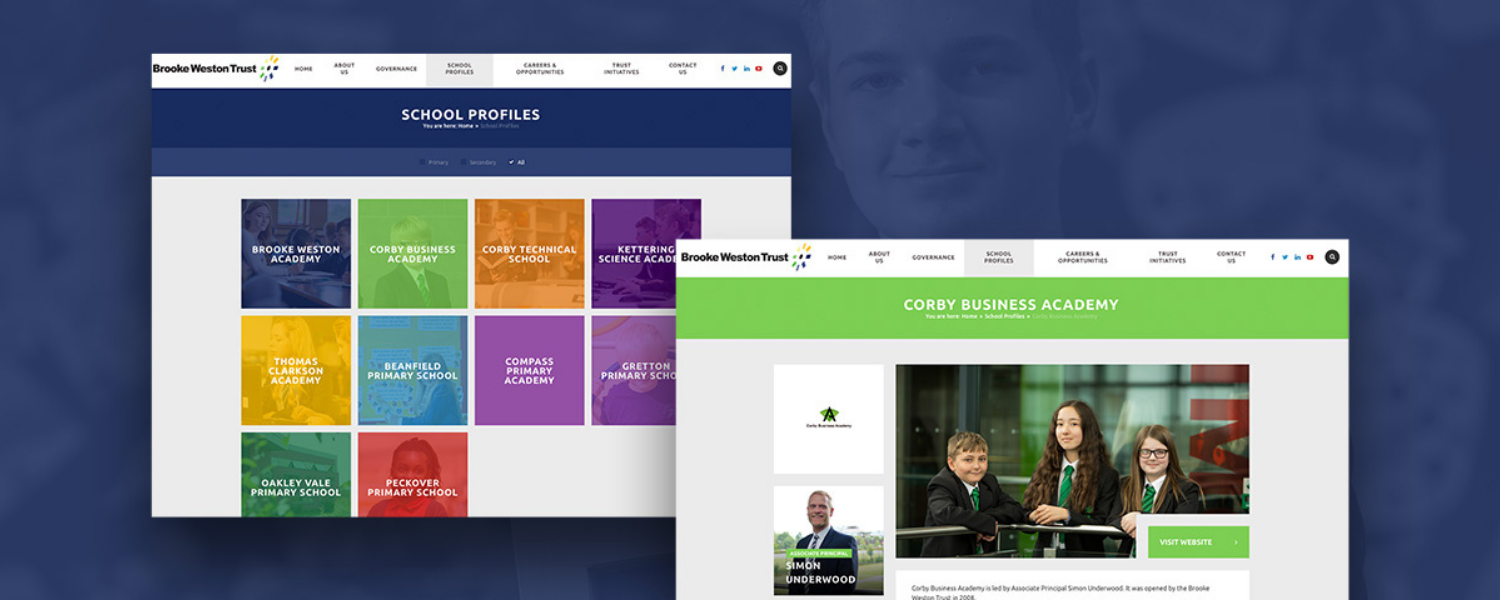Having worked with over 200 multi-academy trusts (and their schools), one question we’ve been asked a lot over the years is ‘what makes a good multi-academy trust website?’
It’s a great question and with trust-wide website projects becoming more frequent and the growth of MATs accelerating, it’s never been more important to ensure that your trust website is the best it can be.
Here's 11 key things you should include for a great multi-academy trust website.
1. The required legal information
The Department for Education (DfE) has created a list of requirements which academy trusts must have on their website to be compliant.
You can access the full guidance by downloading our free website checklist but here's a few of the key things you will need to share on your trust website:
- Your contact details
- Trustees’ information and their duties
- Your annual reports and accounts
- Executive pay
- Performance and assessment details
- Admissions information
- Policies and premiums
- Curriculum and careers
This list is not exhaustive, so please do visit the DfE website or download our checklist to read the full guidance. You may also like to check out our blog post on Academy Trust Financial Requirements.
2. CEO welcome
Just like the headteacher’s welcome on a school website, an introductory message from your CEO is a great way of giving an overview of your organisation and sharing your goals.
If your CEO prefers not to be front and centre of your website, an engaging ‘about us’ statement can also have the same effect. You can share the opening paragraph of your introduction on your homepage and then link to the rest of the message via a call to action (CTA) button – encouraging visitors to stay on your website for longer.
Take a look at Anthem Schools Trust for an example of a ‘Who We Are’ statement which leads into the CEO welcome.
3. Leadership information
People love to put names to faces which is why a leadership team staff page is an engaging way to share an overview of your organisation hierarchy. It can help with directing enquiries to the relevant person and can also show transparency which helps build trust.
Consider showing a photo of each team member alongside their name, job title and a small biography for a real visual impact. The Greenshaw Learning Trust website has pop-out biographies for their SLT, members and trustees.
4. A clear, easy to navigate sitemap structure
The audience for your trust website is likely to be wider than that of a school with parents, students, schools, teachers, employees (current & prospective) and local business leaders visiting your website to find out more.
You may also receive visits from other aspiring or established trusts looking for inspiration or to make comparison.
Consider the information required by each of your key stakeholders and then plan your sitemap to ensure these pages are easily accessible from your menu structure.
ACES Academies and GNET both have streamlined sitemaps with clear headings.
5. News & social media
As with any website, if it’s not regularly updated, people will lose interest and traffic will drop off.
That’s why it’s important for your trust website to be a hive of useful information and to promote the successes and achievements within your wider trust family.
One of the best ways to do this is through a frequently updated news and/or social media feed. You could even choose to automatically share content directly from your school news feeds to help keep things current and strengthen the link between your organisations.
TCES filter their stories on the homepage by category whereas EEEA have them all in one feed and have a subtle logo and colour change to depict which school the story comes from.
6. Content sharing
As mentioned in #1 your policies and key content need to be published online and easily accessible.
If your trust has policies or content which is trust-wide, you could consider using content sharing to push the page content from your trust website onto each of your school sites.
This means that, for example, whenever you update, change or remove a policy at trust-level, you can update it once on your trust website and it can be automatically updated onto the school websites. This saves a huge amount of time and reduces the requirement for duplication, especially useful if you are the administrator for several schools within your trust network (imagine updating the same page 37 times!).
A great example of content sharing functionality can be seen on Consortium Trust. View their policies page and then see how it’s shared to all of their schools using Barnby & North Cove Primary and Glebeland Primary School as examples!
7. Joining the trust - schools
If you are a growing multi-academy trust, one of your key goals will be to attract new schools.
A simple, yet effective way to do this is by having a prominent link to a ‘join our trust’ page full of all the information a school could need to know about joining your organisation.
See these dedicated pages on Swale Academies Trust and Consortium as examples.
8. Joining the trust – recruitment and careers
If employee recruitment is a key driver for you, then a careers page is a vital addition to your multi-academy trust website.
Putting your vacancies all in one place can help to streamline the process and ensure prospective candidates can see what’s available within your wider network at the click of a button.
Maltby Learning Trust has a dedicated careers area showcasing their latest vacancies as well as a secure area for induction. Candidates can also subscribe to get notifications on the latest vacancies.
Hales Valley Trust cleverly combines the recruitment of both schools and employees by having a ‘Work With Us’ section with sub-pages for vacancies, new schools, trainee teachers and governors.
9. School profiles & links
Driving traffic to your school websites can create a positive impact for you and them by driving awareness and helping to provide genuine backlinks for SEO.
You can share your schools in any number of ways – whether it’s a quick link area on the homepage taking you straight off to the school websites like Bedfordshire Schools Trust, or by having a full profile area like this example from Brooke Weston Trust.
10. Multi-pin map
Another innovative way to share your schools, especially if you wish to highlight either the proximity of the schools or the breadth of the area you cover, is through a multi-pin map.
This offers a visual at-a-glance overview of the location of your schools with the option to then click a point or zoom in to see more detail. Lighthouse Schools Partnership has their locations colour-coded by hub and, when clicking a point, you can bring up information about the school and a link off to their website.
Greenshaw Learning Trust uses a similar approach but uses a filter to toggle between their primary and secondary schools. They then have a pop-up about each school when the location icon is clicked.
11. CPD and courses
If you run or host any courses or training sessions throughout the year, you may wish to consider hosting them or sharing them on your website.
Greenshaw Learning Trust uses our remote learning platform to share their Continuous Professional Development (CPD) with their team and wider network, as well as their remote learning resources with their students.
If you run courses, you could also use a course booking system to manage your booking, payment and invoicing requirements through your website – keeping everything in one easy to access location.
Tips for success
Whichever features you choose to include on your multi-academy trust website, make sure you follow our three top tips for success:
Consider your stakeholders
Think about what they want to see and how to ensure this information is easily accessible to them in less than 3 clicks. This could be through a clean and tidy sitemap, clear call to actions or customised quick links from the homepage.
Don’t be afraid to be different
There may be things on this list that just won’t work for your trust, but there might be an alternative suggestion which you feel would make a massive difference to your website presence. If so, share your thoughts! We’d love to make your ideas a reality.
Remember your schools
Whether your schools have autonomy over their website designs or you’re thinking of a more consistent approach, don’t forget to look at the wider picture. Planning a trust-wide website project can often provide a more cohesive look and feel for your whole organisation and can be more cost-effective too.
Thinking about a new website for your multi-academy trust?
- Websites
- Top Tips
You might also like...
New year, new start
A new year (calendar or academic) is the chance for a fresh start. Goals are set, mistakes are relegated to the past and there’s generally a feeling of ‘newness’ in the air. Whether you’re looking for a new school website design, wanting to improve your school newsletter f...
DfE Compliance: Displaying your curriculum on your school website
Your school website is key source of information for parents, students, staff and the community, but there is certain content that you must always have visible on your website, and which will be checked by Ofsted inspectors prior to a visit. We have a full guide to all of these requirements which...






